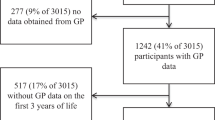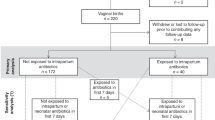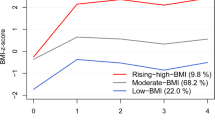Abstract
Objective
Animal studies and epidemiological studies have shown that there is potential sex-specific sensitivity to the intrauterine environment in relation to the developmental programming of obesity. The objective of this study was to assess the sex-specific association between prenatal antibiotics exposure and body mass index (BMI) in offspring from 1 to 4 years.
Methods
A total of 10,163 mother–child pairs from the Medical Birth Registry in Xiamen, China, were included in this prospective cohort study. Data on prenatal antibiotics exposure were collected from the prescription database.
Results
A total of 4909 (48.3%) offspring had prenatal antibiotics exposure. The associations between prenatal antibiotics exposure and offspring’s BMI were significantly different among female offspring and male offspring (P for interaction: 0.034 at 1 year of age; 0.033 at 2 years of age; 0.020 at 3 years of age; and 0.021 at 4 years of age). In female offspring, prenatal antibiotic use was significantly associated with a higher BMI Z-score from 1 to 4 years old (difference in BMI Z-score: 0.11 [95% CI: 0.05–0.17] at 1 years of age; 0.10 [95% CI: 0.05–0.16] at 2 years of age; 0.14 [95% CI: 0.09–0.21] at 3 years of age; and 0.13 [95% CI: 0.07–0.19] at 4 years of age) after adjustment for confounder. Prenatal antibiotics use was not associated with offspring BMI Z-score from 1 to 4 years in male offspring.
Conclusions
The association of prenatal antibiotics exposure and BMI Z-score from 1 to 4 years old may differ by sex of offspring.
This is a preview of subscription content, access via your institution
Access options
Subscribe to this journal
Receive 12 print issues and online access
$259.00 per year
only $21.58 per issue
Buy this article
- Purchase on SpringerLink
- Instant access to full article PDF
Prices may be subject to local taxes which are calculated during checkout

Similar content being viewed by others
References
Singh AS, Mulder C, Twisk JW, van Mechelen W, Chinapaw MJ. Tracking of childhood overweight into adulthood: a systematic review of the literature. Obes Rev. 2008;9:474–88.
Pothuraju R, Rachagani S, Junker WM, Chaudhary S, Saraswathi V, Kaur S, et al. Pancreatic cancer associated with obesity and diabetes: an alternative approach for its targeting. J Exp Clin Cancer Res. 2018;37:319.
Hales CN, Barker DJ, Clark PM, Cox LJ, Fall C, Osmond C, et al. Fetal and infant growth and impaired glucose tolerance at age 64. BMJ. 1991;303:1019–22.
Schulz LC. The Dutch Hunger Winter and the developmental origins of health and disease. Proc Natl Acad Sci USA. 2010;107:16757–8.
Ledger WJ, Blaser MJ. Are we using too many antibiotics during pregnancy? BJOG. 2013;120:1450–2.
Zhang M, Differding MK, Benjamin-Neelon SE, Ostbye T, Hoyo C, Mueller NT. Association of prenatal antibiotics with measures of infant adiposity and the gut microbiome. Ann Clin Microbiol Antimicrob. 2019;18:18.
National Diabetes Data Group. Classification and diagnosis of diabetes mellitus and other categories of glucose intolerance. Diabetes. 1979;28:1039–57.
Mueller NT, Whyatt R, Hoepner L, Oberfield S, Dominguez-Bello MG, Widen EM, et al. Prenatal exposure to antibiotics, cesarean section and risk of childhood obesity. Int J Obes. 2015;39:665–70.
Mor A, Antonsen S, Kahlert J, Holsteen V, Jorgensen S, Holm-Pedersen J, et al. Prenatal exposure to systemic antibacterials and overweight and obesity in Danish schoolchildren: a prevalence study. Int J Obes. 2015;39:1450–5.
Wang B, Liu J, Zhang Y, Yan C, Wang H, Jiang F, et al. Prenatal exposure to antibiotics and risk of childhood obesity in a multicenter cohort study. Am J Epidemiol. 2018;187:2159–67.
Heerman WJ, Daley MF, Boone-Heinonen J, Rifas-Shiman SL, Bailey LC, Forrest CB, et al. Maternal antibiotic use during pregnancy and childhood obesity at age 5 years. Int J Obes. 2019;43:1202–9.
NCD Risk Collaboration (NCD-RisC) Worldwide trends in body-mass index, underweight, overweight, and obesity from 1975 to 2016: a pooled analysis of 2416 population-based measurement studies in 128.9 million children, adolescents, and adults. Lancet. 2017;390:2627–42.
Gabory A, Attig L, Junien C. Sexual dimorphism in environmental epigenetic programming. Mol Cell Endocrinol. 2009;304:8–18.
Dearden L, Bouret SG, Ozanne SE. Sex and gender differences in developmental programming of metabolism. Mol Metab. 2018;15:8–19.
Shi X, Huang P, Wang L, Lu W, Su W, Yan B, et al. Maternal postload 1-hour glucose level during pregnancy and offspring's overweight/obesity status in preschool age. BMJ Open Diabetes Res Care. 2020;8:e000738.
Li H, Ji CY, Zong XN, Zhang YQ. Body mass index growth curves for chinese children and adolescent aged 0 to 18 years. Chin J Pediatr. 2009;47:493–8.
Yang J, Lernmark A, Uusitalo UM, Lynch KF, Veijola R, Winkler C, et al. Prevalence of obesity was related to HLA-DQ in 2-4-year-old children at genetic risk for type 1 diabetes. Int J Obes. 2014;38:1491–6.
Cassidy-Bushrow AE, Burmeister C, Havstad S, Levin AM, Lynch SV, Ownby DR, et al. Prenatal antimicrobial use and early-childhood body mass index. Int J Obes. 2018;42:1–7.
Desai M, Jellyman JK, Ross MG. Epigenomics, gestational programming and risk of metabolic syndrome. Int J Obes. 2015;39:633–41.
Hawkes CP, Hourihane JO, Kenny LC, Irvine AD, Kiely M, Murray DM. Gender- and gestational age-specific body fat percentage at birth. Pediatrics. 2011;128:e645–51.
Katkhuda R, Peterson ES, Roghair RD, Norris AW, Scholz TD, Segar JL. Sex-specific programming of hypertension in offspring of late-gestation diabetic rats. Pediatr Res. 2012;72:352–61.
Li S, Zhu Y, Yeung E, Chavarro JE, Yuan C, Field AE, et al. Offspring risk of obesity in childhood, adolescence and adulthood in relation to gestational diabetes mellitus: a sex-specific association. Int J Epidemiol. 2017;46:1533–41.
Jess T. Microbiota, antibiotics, and obesity. New Eng J Med. 2014;371:2526–28.
Riley LW, Raphael E, Faerstein E. Obesity in the United States – dysbiosis from exposure to low-dose antibiotics? Front Public Health. 2013;1:69–77.
Gomez-Arango LF, Barrett HL, McIntyre HD, Callaway LK, Morrison M, Dekker Nitert M. Antibiotic treatment at delivery shapes the initial oralmicrobiome in neonates. Sci Rep. 2017;7:43481–91.
Shao X, Ding X, Wang B, Li L, An X, Yao Q, et al. Antibiotic exposure in early life increases risk of childhood obesity: a systematic review and meta-analysis. Front Endocrinol. 2017;8:170–80.
Champagne-Jorgensen K, Mian MF, Kay S, Hanani H, Ziv O, McVey Neufeld KA, et al. Prenatal low-dose penicillin results in long-term sex-specific changes to murine behaviour, immune regulation, and gut microbiota. Brain Behav Immun. 2020;84:154–63.
Chen X, Wang L, Loh DH, Colwell CS, Taché Y, Reue K. et al. Sex differences in diurnal rhythms of food intake in mice caused by gonadal hormonesand complement of sex chromosomes. Hormones Behav. 2015;75:55–63.
Clegg DJ, Riedy CA, Smith KA, Benoit SC, Woods SC. Differential sensitivity to central leptin and insulin in male and female rats. Diabetes. 2003;52:682–87.
Zhang FF, Cardarelli R, Carroll J, Fulda KG, Kaur M, Gonzalez K, et al. Significant differences in global genomic DNA methylation by gender andrace/ethnicity in peripheral blood. Epigenetics. 2011;6:623–29.
Acknowledgements
We would like to thank all the doctors, nurses, technicians, and patients involved in their dedication to the study.
Author information
Authors and Affiliations
Contributions
ML, HS, and XS designed and performed the data analysis and drafted the paper. WL and WS conceived this study. FY, BH, YZ, SW, and FL collected data. XL and XS critically reviewed the paper for important intellectual content. All authors contributed significantly to the data analysis and reviewed and approved the final paper.
Corresponding author
Ethics declarations
Conflict of interest
The authors declare that they have no conflict of interest.
Additional information
Publisher’s note Springer Nature remains neutral with regard to jurisdictional claims in published maps and institutional affiliations.
Supplementary information
Rights and permissions
About this article
Cite this article
Lin, M., Song, H., Liu, W. et al. Sex-specific associations between prenatal antibiotics exposure and offspring’s body mass index. Int J Obes 44, 2044–2051 (2020). https://doi.org/10.1038/s41366-020-0629-0
Received:
Revised:
Accepted:
Published:
Issue date:
DOI: https://doi.org/10.1038/s41366-020-0629-0
This article is cited by
-
Antibiotics in elderly Chinese population and their relations with hypertension and pulse pressure
Environmental Science and Pollution Research (2022)



